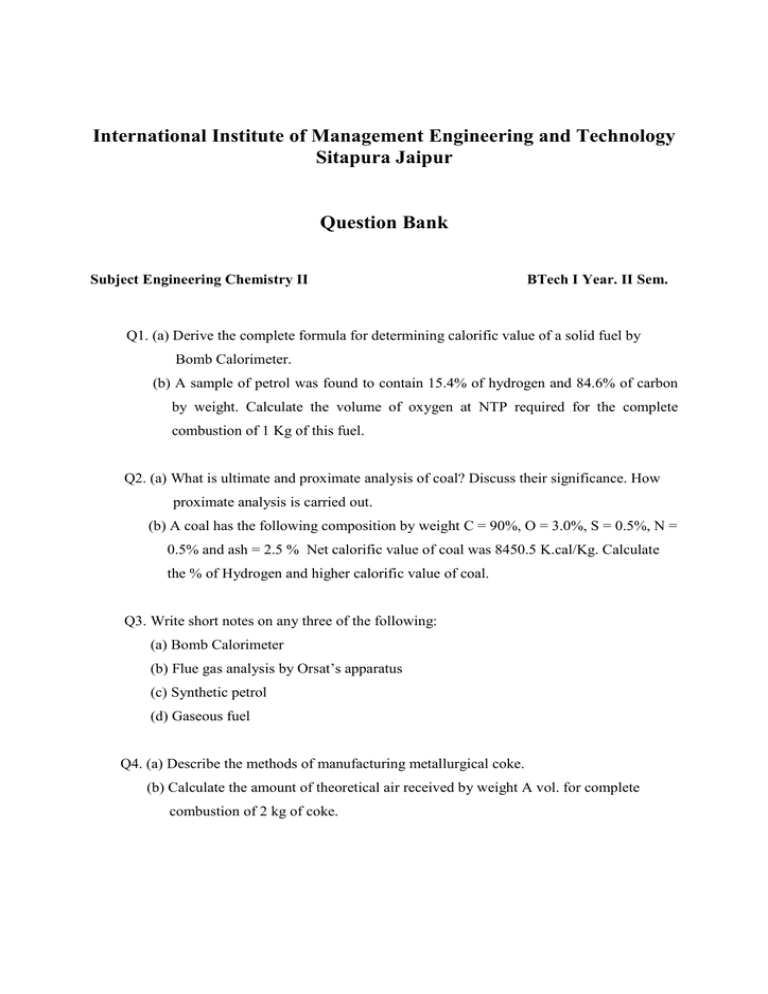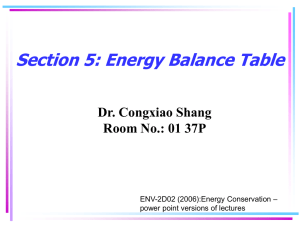International Institute of Management Engineering and Technology Sitapura Jaipur Question Bank
advertisement

International Institute of Management Engineering and Technology Sitapura Jaipur Question Bank Subject Engineering Chemistry II BTech I Year. II Sem. Q1. (a) Derive the complete formula for determining calorific value of a solid fuel by Bomb Calorimeter. (b) A sample of petrol was found to contain 15.4% of hydrogen and 84.6% of carbon by weight. Calculate the volume of oxygen at NTP required for the complete combustion of 1 Kg of this fuel. Q2. (a) What is ultimate and proximate analysis of coal? Discuss their significance. How proximate analysis is carried out. (b) A coal has the following composition by weight C = 90%, O = 3.0%, S = 0.5%, N = 0.5% and ash = 2.5 % Net calorific value of coal was 8450.5 K.cal/Kg. Calculate the % of Hydrogen and higher calorific value of coal. Q3. Write short notes on any three of the following: (a) Bomb Calorimeter (b) Flue gas analysis by Orsat’s apparatus (c) Synthetic petrol (d) Gaseous fuel Q4. (a) Describe the methods of manufacturing metallurgical coke. (b) Calculate the amount of theoretical air received by weight A vol. for complete combustion of 2 kg of coke. Q5. (a) Write short notes on (i) Coal gas (ii) Determination of calorific values by Junker’s calorimeter (b) The ultimate analysis of coal gives C = 84%, S = 1.5%, N = 0.6%, H = 5.5%, O = 8.4% Calculate the gross and net calorific value of the sample. Q6. (a) What is carbonization of coal and how it is developed? Give the manufacture of metallurgical coke by otto hoffmann’s by product coke oven process. (b) A sample of coal was found to have the following % composition by weight C= 75%, H= 5.2%, O= 12.1%, N= 3.2% and ash = 4.5% Calculate (i) The minimum amount of O2 and air by weight necessary for complete combustion of 1 Kg of Coal. (ii) Weight of air reduced if 40% excess of air is supplied. (iii) Gross and net calorific value of coal sample using Dulong’s formula. Q.7 (a) What is meant by term cracking? What are the advantages of catalytic cracking process? Describe with a neat and labeled diagram of moving bed catalytic cracking process. (b) The following data are obtained in a Junker’s calorimeter experiment: Vol. of gas used = 0.1 m3 at STP Vol. of water heated = 25 Kg Temp. of inlet water = 200 C Temp. of outlet water = 330C Weight of steam condenser = 0.025 Kg Calculate the higher and lower calorific value per m3 at STP. Take the heat-liberated in condensing water vapour and cooling the condensate as 580 Kcal/g. Q8. (a) What is calorific value of solid fuel. Explain the determination of calorific value by bomb calorimeter. (b) The % composition by weight of a sample of coal was found to be as under: C= 81%, H= 5%, O= 8.5%, S= 1% and ash= 3.5%, calculate the minimum amount of O2 and air volume for complete combustion of 1 Kg to this coal. Q9. (a) What is synthetic petrol? Describe Fischer Tropsch process. How this process differs from Bergius process. (b) Write short note on any two (i) Proximate analysis of coal (ii) Coke preparation by Otto Von Hoffman’s method (iii) Oil gas Q10. (a) Drawing a neat sketch, describe how gasoline can be synthesized from water gas, (b) Draw neat and labeled diagram of coke manufactured by Otto Von Hoffman’s by product coke oven. Process Q11. (a) Write short notes on (i) Metallurgical coke (ii) Cracking and octane number (b) Explain the following terms: catalytic cracking and its advantages. What are knocking and octane number? How these are related to the chemical structure of the fuel. Q12. (a) Describe the methods of manufacturing of metallurgical coke. (b) Write short notes on (i) Flue gas analysis by Orsat’s apparatus (ii) Ultimate analysis of Coal Q13. (a) Give experimental details for calculating higher and lower calorific values of solid fuel and derive the formula for the same. (b) Write short notes on: (i) Proximate analysis (ii) Calorific value (iii) Coal gas Q14. (a) What is meant by latent heat of vaporization of water. How does it explain lower and higher calorific value of the fuel (b) Explain methods of proximate analysis of coal. Why is proximate analysis is preferred over ultimate analysis in industries? . Q15. (a) Write short note on Beehive’s oven method for manufacture of metallurgical coke? (b) 0.72 gram of a fuel containing 80% carbon, when burnt in a bomb calorimeter increased the temperature of water from 27.30 C to 29.1 C. If the calorimeter contains 250 grams of water and its water equivalent is 150 grams. Calculate the HCV of the fuel. Q16. (a) Derive the complete formula for determining calorific value of a gaseous fuel by Junker’s Calorimeter. (b) A gaseous fuel have the following composition by volume. H2 = 20%; CH4 = 5%, CO = 20%; CO2 = 5%; N2 = 50%. If 50% excess of air is used, find the weight of air actually supplied per m3 of this gas. By (Prof. A. P. Shukla) HOD B Tech I Year



